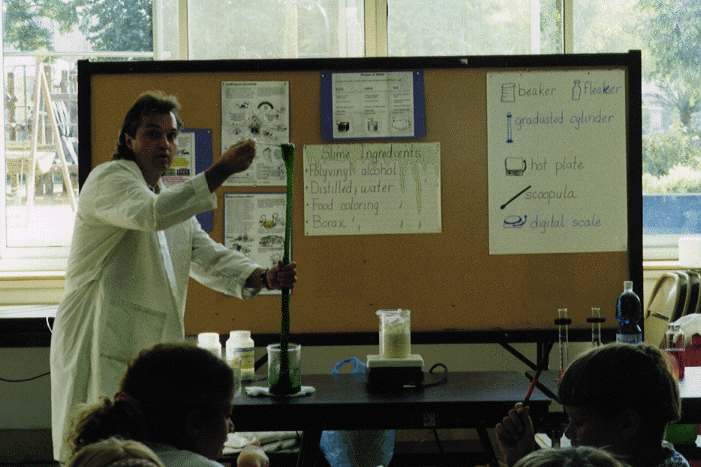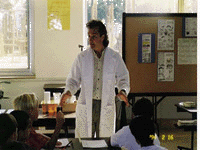| Sharing Science | |||||||||||
| Kids Teaching Kids: Student Outline | |||||||||||
| Be An Einstein...Ask Why? | |||||||||||
| On-Line Physics | |||||||||||
| Enrichments | |||||||||||
| Collaboratives | |||||||||||



Gases and liquids are classified as fluids because both are able to flow and to change their shapes. Sir Isaac Newton (1642-1727) is credited with stating the relationship between temperature and the viscosity of fluids. This law of Viscosity states that only a change in temperature affects the viscosity of a fluid. Newton had never seen the "Glob", a creepy ooze that, like other fluids, has an increase in molecular motion with an increase in temperature but that, unlike other fluids, has its viscosity increase with an increase in pressure. Pressure makes it behave as a solid. Since "Glob" defies Newtonian Law's about fluids, it is considered a "non-Newtonian" fluid.
A. Make the Glob using the following instructions, caution it is not edible.
- ·Combine 4 ounces (120 mL) of Elmer's school glue, 4 ounces (120 mL) of distilled water,
- and ten drops of green food coloring. Stir well and set aside.
- ·In a separate bowl, combine 1 teaspoon (5 mL) of sodium borax with 1 cup (250 mL) of distilled water. Stir well.
- ·Pour both solutions into an empty bowl simultaneously.
- ·Stir and dip the thick Glob out of the bowl
- ·Knead the Glob with your hands until it is smooth and dry.
B. Try the following experiments with Glob:
- ·Roll it into a ball and bounce it on a smooth surface
- ·Hold it in your hands and quickly pull the ends in opposite directions
- ·Hold it in your hands and slowly pull the ends in opposite directions
- ·Place a lemon-size piece into a microwave dish and heat for one half minute in the oven.
- Caution this will make the Glob too hot to handle. Allow it to stand in the oven for about 5
- minutes so that it returns to room temperature.
- ·Place a piece in a freezer overnight and then allow it to return to room temperature.
Note: the Glob will keep for weeks in a plastic bag, but after a lot of handling it will eventually dry out.
Another Way!!
Slime-type materials can be made from polyvinyl alcohol, a substance used as a thickener, stabilizer, and binder in cosmetics, paper cloth, films, cements and mortars. Slime since 1979 has become a very popular demonstration activity in chemistry and science classes. The use of polyvinyl alcohol solutions is what has been predominately used in the preparation of most slimes, especially those that have been used for specialty toys and items for children. The danger of those materials, just as the Glob above are not edible, or utilize very dangerous materials. Upon the drying of polyvinyl alcohol solutions, they will leave a thin film of plastic that is finding its use in packaging materials. This film, is left in the environment and will break down rather than persist as some plastics do, thus it requires no clean up. The following is a way that you can produce slime with the use of polyvinyl alcohol and Borax:
Test the properties of "Slime"
- Pull the Slime slowly. What happens?
- Pull the Slime hard. What happens?
- Roll a piece of Slime into a ball and drop it. What happens?
- Place a small piece of Slime on the table top. Hit it with your hand. What happens?
- Write your name on a piece of paper with a felt-tip pen.
- Place the Slime on your name, then lift it up. Did anything happen? Can you explain why?
- Repeat the procedure with different brands of felt-tip pens.
- Store the Slime in a plastic bag.
And Yet Another Way:
The following method that I developed was inspired by the question received by Rilke in Ms. Edward's third grade class at the International School of Prague. Her question was in request of a "Slime" recipe or the making of plastics, Thinking about the need for a recipe, I presented the above two, but after thinking about it longer, I realized that it would be a great way to become creative and innovative in developing a safer way to produce the slime. So here it goes!
Materials needed:
- 100 mL beaker or paper cup (5 oz)
- graduated cylinder, 25 mL
- stirring rod
- water warmed to 60o C or hot tap water will be adequate
- Polyvinyl alcohol packaging materials (dissolvable packing bubbles)
- 4 % solution of Acacia by weight
- 10 grams Corn Starch or Soluble Starch
- 5 grams of Baking Soda (NaHCO3)
- Food coloring of your choice to color Slime (optional)
- graduated cylinder, 25 mL
Procedure:
Wear safety goggles or glasses at all times in the Laboratory. There are no hazards associated with the polyvinyl alcohol or any of the other materials. This procedure utilizes hot water so caution should be taken. Take care with the chemicals so as, to keep them and the Slime away from your clothes or cloth covered furniture because it could produce permanent stains. The Slime will get dirty from handling and may become moldy after several days. When this occurs, the Slime should be discarded. Dispose of any Slime in the trash or simply flush down the sink with hot water, the prior is preferred, because at times the Slime could clog the drain.
If the warm water is ready, measure out 25 mL and place into a beaker or paper cup. Add pieces of polyvinyl alcohol packaging materials (approximately 1.5-2.0 grams) into the warmed water in beaker or paper cup. Stir well to dissolve and disperse the polymer. If desired, one to two drops of food coloring can be added to the polyvinyl solution. Stir the mixture. Measure out 5 mL of the 4% Acacia solution. Pour the Acacia solution into the cup and stir well. Now add the above mass of Corn Starch and Baking Powder. Caution, the mixture may have a tendency to cause effervescence, so make sure you continue stirring the solution during the mixing process. Stir continuously for approximately 5 minutes. Now with your stirring rod take the material from the cup and place on a piece of wax paper, knead slowly with your hand. The material will eventually become firm and lose some of its stickiness. Now, you are ready to test your "Properties of Slime!!"
Last little tidbit, this Slime is edible, even though it is not recommended, it is not a serious threat, if an elementary student accidentally ingests some of the material.
Other Recipes!
The following and previous recipes are adaptations of those found in "The Science Teacher", my own Demonstration files, and from a presentation by Cheryl Burleigh on "Kitchen Chemistry" done at the 1996 NSTA Global Summit on Science Education.
PVA Slime by Cheryl Burleigh
Materials:
- 2 oz 2% Polyvinyl Alcohol (PVA)
- 2 oz 2% Sodium Tetraborate
- Medicine Dropper, test tube, 100 mL Beaker
- Craft Stick and Paper Cup
- 2 oz 2% Sodium Tetraborate
Procedure:
1. Pour approximately 1 oz of PVA into the 100 mL beaker
2. Measure 1 mL of sodium tetraborate solution, using the dropper. Squirt the sodium tetraborate into the beaker and stir like crazy with the craft stick to produce the slime.
3. Examine the properties of the cross-linked polymer. If thicker slime is desired, repeat step 2 as many times as you want. Usually using 2 or 3 mL produces the best slime.
4. If you would like to save time, place it into a baggie. It will last longer if it is placed in the refrigerator.
Fried Peanuts by Cheryl Burleigh adapted from the "Science Teacher"
Materials:
- 2 oz Acetone or Nail Polish remover
- 100 mL Beaker
- Polystyrene Peanuts
- 100 mL Beaker
Procedure:
1. Fill the beaker with enough acetone to cover the bottom about a quarter of an inch deep.
2. Start adding the peanuts and see how many you can get into the beaker before it is full. Please keep count of the peanuts.
3. Pull the blob out and play with it. The acetone will not hurt your hands but it may dry out your skin a bit. Rinse your hands with water.
4. When you are done, place the blob into a baggie.
Collapsible Cup adapted from the "Science Teacher"
Materials:
- Acetone or Nail Polish remover
- Polystyrene Cup
- Small Pie Tin
- Baggie and Paper Towels
- Polystyrene Cup
Procedure:
1. Fill the pie tin with just enough acetone or nail polish remover to fill the bottom about a quarter of an inch.
2. Put the cup upside down in the pie tin and gently push until the cup is completely gone and there is just a white blob left.
3. Pull the blob out and play with it as in the Fried Peanuts. Examine the properties. When done store in plastic baggie.
If you would like any information on these or other collaborative programs please use the following e-mail address: send mail to kskrutvold@uswest.net.